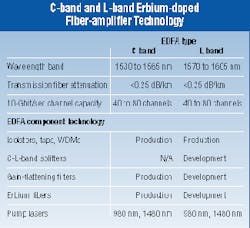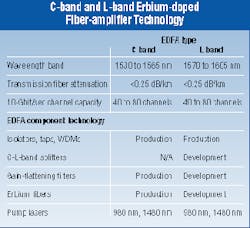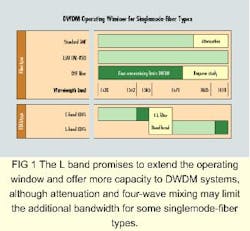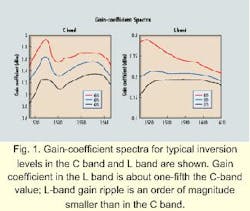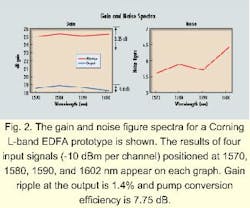Amplifiers designed for the L band
Driven by the Internet and new data-communications services, demand for bandwidth in long-distance networks doubles at least every two years. Today, some long-haul fibers carry 50 to 100 Gbits/sec per route, and traffic in many networks grows from 30% to 150% annually. These capacity requirements surpass the reach of traditional time-division multiplexing (TDM) upgrade paths. Technologies such as erbium-doped fiber amplifiers (EDFAs) and dense wavelength-division multiplexing (DWDM) enable system planners to meet current demand, but as advanced data-communications systems proliferate, service providers continue to need more capacity at lower cost.
Fortunately, room for more bandwidth already exists in optical fiber. The "conventional" (C) wavelength band of EDFAs extends from about 1530 to 1562 nm. It has been used for the introduction of 2-, 4-, 8-, 16-, 32-, 40-, 80-, and 96-channel DWDM systems since the introduction of EDFA technology in 1994. It's important to note the transmission window's range could increase as amplifiers become more complex.
Recent interest by system operators in accessing more bandwidth-and in some cases different bandwidth-has drawn attention to new optical components designed to operate in the "long" (L) wavelength-transmission window. L-band EDFAs provide an attractive option for expanding bandwidth. These amplifiers, operating in (approximately) the 1570- to 1605-nm wavelength window, add more room for channels in high-data-rate systems. The additional channel bandwidth addresses nonlinear effects in fiber-a significant impairment that has prevented further increases in transmission capacity. Like the C band, the range of the L band could increase as amplifiers evolve.
Beginning next year, L-band amplifiers will appear in several DWDM applications. The availability of this new wavelength window creates an opportunity for system designers to rethink their options.
Note the following potential applications for this window:
- Extending the capacity of wavelength-exhausted, conventional singlemode-fiber (SMF) and Corning LEAF fiber networks
- Defeating the nonlinear four-wave-mixing (FWM) impairment inherent with dispersion-shifted fiber (DSF) networks
- Increasing wavelength-channel spacing to take advantage of lower-cost wavelength-division multiplexing (WDM) and transmission lasers
- Creating unique bidirectional amplifier topologies using both the C and L bands
- Segmenting different types of data in operating networks; dedicating the L band for a specific service.
L-band EDFAs must also cost about the same as C-band amplifiers in high-volume quantities. In most cases, the L-band amplifiers will be added modularly via bandsplitter and combiner technologies to existing C-band amplified systems.
Combining the C band with the L band allows network providers to double the transmission window for WDM from about 32 to 64 nm. Service providers can operate 40 to 80 channels or more at OC-48 (2.5 Gbits/sec) or OC-192 (10 Gbits/sec) in each band, a potential total capacity approaching 1 Tbit/sec (1000 Gbits/sec). This modularity allows a "pay-as-you-grow" path for wavelength upgrades. Demand for L-band EDFAs is expected to begin toward year-end.
The L band of conventional SMF is a promising option for users interested in upgrading their legacy fiber networks. Many long-distance and regional networks have insufficient amounts of installed standard G.652-type SMF. Median fiber counts range from 15 to 35 in global long-distance networks; some fiber cables have as few as 10 fibers installed. Economically, choosing the L band is a good decision in situations where users are leasing fibers and want to maximize the capacity on a fiber or to avoid or delay the potential high cost of instal ling a new transmission cable.
A number of issues merit exploration when system planners consider an L-band upgrade on SMF networks, such as the onset of bending-induced loss in vintage fibers. Today, data gathering of outside-plant fiber cable is occurring in several long-haul networks to determine the actual attenuation performance of the L band. Still, high-cabled attenuation from 1570 to 1610 nm is not expected to become an issue for most installed networks. Several operators are already moving ahead with plans to use the window to access new bandwidth.
One of the first L-band applications will be to alleviate nonlinear effects that limit bandwidth capacity on DSF. This fiber was designed with the zero-dispersion, crossing wavelength centered near the 1550-nm wavelength to optimize transmission-signal attenuation and dispersion performance. Studies later revealed that this characteristic was the primary source of potential nonlinear effects that appear as mixing-induced noise in DWDM applications.
The number of DWDM channels on DSF is limited to less than 10 channels in the C band due to the FWM nonlinear effect. But at longer wavelengths, the fiber exhibits nonzero dispersion and is fit for multichannel DWDM operation. The Figure compares the DWDM operating window for SMF types.
L-band EDFAs may substantially extend the bandwidth capabilities of some DSF-types. Some system operators with DSF networks may even begin to use the L band before the C band. The L band could become the dominant band for these fibers as operators look to minimize the cost of amplifier upgrades (C-band EDFAs would reach maximum capacity at much smaller channel counts).
This application is beginning to surface as users are exhausting the usable wavelengths of DSF. What's needed now is a better understanding of the DSF's optical characteristics in the L band and the commercial availability of transmitters, WDMs, and L-band amplifiers.
The best option for system architecture clearly depends on the evaluation of costs, projected capacity requirements for a route, network reliability, and other factors. In light of the ongoing quest for greater bandwidth, optical components designed to operate at longer wavelengths provide practical and economical solutions to service providers because they increase capacity, address nonlinear FWM impairment, and offer a "pay-as-you-grow" path for wavelength upgrades.
Finally, EDFA performance is largely determined by the operation of the internal components-the isolator, tap, WDM, filters, and band splitters. Therefore, what's needed are components specified for the L band. As service providers begin to fill the C band, the additional capacity provided by L-band technology will be an essential part of many future DWDM systems. u
George Wildeman is the product-line manager for optical amplifiers, and Felton Flood is a senior research and development scientist, both at Corning Inc. (Corning, NY).Current erbium-doped fiber amplifiers (EDFAs) operate in the conventional (C) band defined as 1530 to 1562 nm; this wavelength range encompasses the erbium gain peak. The long-wavelength band (L band) or extended band (E band) is defined approximately as 1570 to 1605 nm; this wavelength range encompasses only the tail of the erbium gain band. (The range of both transmission windows can vary by several nanometers.) L-band EDFAs are further distinguished by the comparatively long erbium coil lengths required for amplification.
Despite these differences, the functionality and performance of L-band EDFAs can match that of the most advanced C-band amplifiers. In fact, the design and architecture of L-band amplifiers are quite similar to that of standard C-band amplifiers. Several basic technical issues are related to the design and development of L-band EDFAs: L-band EDFA development hinges on three basic technical issues: operating environment, pump wavelengths, and amplifier architecture and performance.
The difference between C- and L-band amplifier coil length is a direct result of the distinct operating environments. Amplifier gain (G) is expressed as G = gc x L, where gc (dB/meter) is the gain coefficient and L (meter) is the erbium-coil length. In the L band, emission and absorption coefficients are three to four times smaller than the corresponding C-band values. In addition, L-band amplifiers operate at very low average inversion levels (~40%) to minimize the intrinsic-gain ripple. The average amplifier inversion level defines the percentage of erbium ions that contribute to the amplification process. For reference, C-band amplifiers typically operate at 60% to 65% average inversion. Gain ripple is defined by the minimum and maximum amplifier gain as [(Gmax -Gmin)/Gmin] x 100%.The smaller emission and absorption coefficients along with the low average inversion cause the L-band gain coefficient to be significantly smaller than C band (see Fig. 1). The lower gain coefficient results in L-band amplifier (using standard Type-2 fiber) coil lengths that are four to five times longer than what is required for comparable C-band amplifiers. It is important to note, however, that the L-band gain ripple is an order of magnitude smaller than what is observed for C band. The lower gain ripple means that L-band gain-flattening filters (GFFs) are easier to manufacture and produce less amplifier performance degradation (due to filter attenuation) than C-band GFFs.
Despite this advantage, the longer L-band erbium-coil length poses several fundamental challenges. First, the total passive fiber loss is higher; this decreases pump conversion efficiency (PCE), since both pump and signal powers experience greater attenuation. PCE defines the pump power required to provide a given signal output power; thus, anytime pump photons are not used to amplify the signal, PCE is degraded. Pump power is often completely absorbed well before the output end of the erbium fiber. In these cases, signals encounter a net absorptive loss in the unpumped fiber region, which also reduces PCE.
Next, the longer coil lengths result in substantial accumulation of backward amplified spontaneous emission (ASE) power. Again, PCE is degraded because pump photons are used to amplify backward ASE instead of signal power. Backward ASE also reduces inversion at the front end of the amplifier, which increases noise figure. Hence, the PCE (i.e., required pump power) and noise-figure performance of L-band EDFAs is generally worse than what is observed for comparable C-band amplifiers.The L-band operating environment also affects pump wavelength options. In the C-band, PCE (lpump = 980 nm) < PCE (lpump = 1480 nm) because of the difference in photon energy conversion: lpump/lsignal. The difference between PCE when lpump = 980 nm versus lpump = 1480 nm is even greater in the L band. Since pump laser cost represents a substantial portion of the total amplifier cost, increasing PCE is a concern for commercial L-band amplifier development.
One method to improve PCE in the L band is pump wavelength tuning. The 980-nm PCE can improve by several decibels when the pump wavelength is tuned ±25 nm away from the pump absorption peak at 980 nm. Pump wavelength tuning is also an option for 1480-nm pumped L-band amplifiers. Because of the low-inversion operating environment, the L band can be pumped efficiently at wavelengths as high as 1550 nm. This result is significant because it creates the possibility of ASE pumping, wherein backward ASE (peaked near 1532 nm) is employed as pump power. ASE pumping is the effective reuse of pump power that has been converted into ASE power. A second possibility is the use of fiber lasers as high-power pumps for the L-band amplifier. Thus, the L-band offers some novel options for pump wavelength and pump configuration.
A Corning L-band amplifier prototype was demonstrated in February at OFC '99. The amplifier gain spectrum in the prototype was flattened at the midstage (to allow access) and at the output. Signals were monitored at all access points (see Fig. 2).
The Corning L-band amplifier demonstrated 1.4% gain ripple (0.35-dB ripple per 25-dB gain), which is smaller than the typical C-band gain ripple of 4% to 6%. The noise figure for the prototype was ~1 dB greater than C-band values, and PCE was ~2 dB worse than in the C band. The initial amplifier stage was pumped with lpump = 980 nm to achieve high front-end inversion. The final amplification stage was pumped with lpump = 1480 nm to exploit the higher PCE associated with this pump wavelength band. This same paradigm is used in C-band amplifiers. As indicated by Corning's research and development, much of the design and manufacturing knowledge gained from the production of C-band amplifiers can be applied to L-band EDFAs. The development of L-band EDFAs is proceeding at an aggressive pace. It is expected that these next-generation amplifiers will have a significant impact on lightwave systems in the near future.
